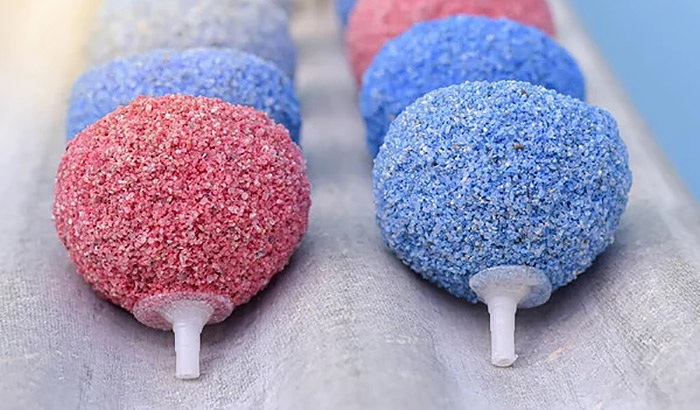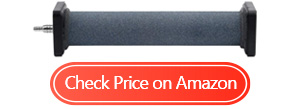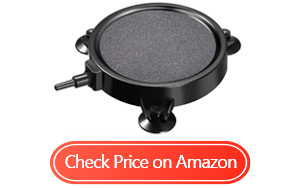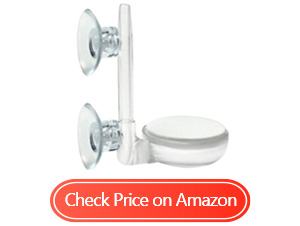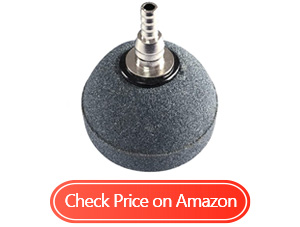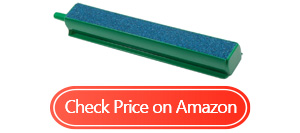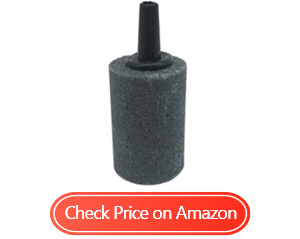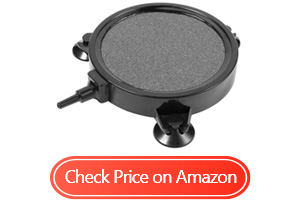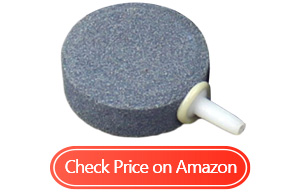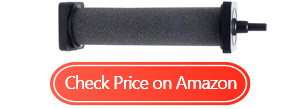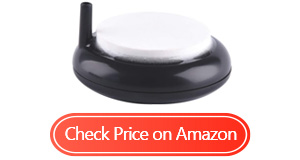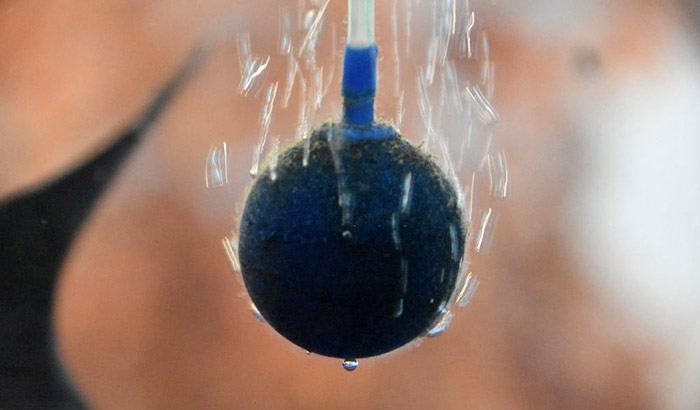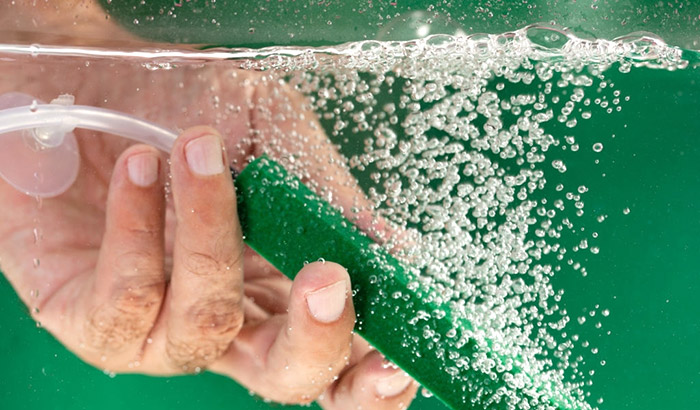The best aquarium air stone is one that can produce a multitude of tiny bubbles, which would dissipate a couple of seconds later and impart oxygen into the water. The more oxygen the water has, the easier it will be for the fish to breathe.
However, aerating the water is not the only thing that an aquarium air diffuser stone does. For instance, the bubbles it produces also displace a lot of water (air occupies space), and this results in the water circulating the tank. This is important as it will ensure that there is no stagnant water in the tank that does not contain enough oxygen.
Most people do not think too much about what air stones they place in their aquariums. However, if you want your tank to become a balanced and thriving ecosystem, a good air stone is essential. This article will teach you about the different types of air stones that will be highly beneficial to your aquarium.
Contents
Best Aquarium Air Stone Reviews
1. Pawfly Aquarium Air Stone Cylinder
This product is a rather large air stone. It is 8 inches long, so it has a large surface area to produce more air bubbles. Compared to the dinky air stones that you usually see in most aquarium supply stores, this 8-inch air stone produces enough bubbles for large aquariums. I am currently using it on my 75-gallon tank and it is working just fine.
Because it is much bigger than traditional air stones, this one is much easier to clean. It is easier to hold and brush, unlike the smaller air stones that you must pinch in between your fingers to hold. I have dropped quite a lot of air stones because I could not hold them properly and many of them broke in half.
Another reason why I like this air stone is that it is heavy enough that you do not need to weigh it down to make it stay put on the bottom of the tank. However, I still do use a suction cup hook to keep the hose out of the way. Note, though, that even at full blast, the air stone remains in place.
However, because of its size, you may need to use a larger air stone pump for the fish tank, which means that you will be using a larger diameter rubber hose, and that is okay. This air stone can accommodate both 3/16” and 3/8” rubber hoses. The larger one allows more air to pass through the stone, which means it can produce more bubbles.
As mentioned earlier, the only downside to using this fine bubble air stone is that you will need a rather strong air pump to push air through the entire length of the air stone. If you already have a small 3-watt air pump, it will not be strong enough to push air out of this huge air stone.
- Produces a lot of tiny bubbles
- Easy to clean
- Heavy enough that it sinks to the bottom unaided
- Can use both 3/16” and 3/8” rubber hoses
- This stone needs a stronger pump to make full use of it
Although this aquarium bubble maker is ideal for outdoor ponds, you would benefit from it if you have a big tank. This air stone is big enough and produces so many bubbles that you might not even need another pump to circulate the water in the tank. If your aquarium is 70 gallons or bigger, then you would want to check this product out.
2. Mudder Air Stone Disc Bubble Diffuser
Even if you are a complete newbie when it comes to keeping aquariums, you will have no problem installing this air stone. You just need to connect the rubber hose to the air inlet, and then push this air stone down on the base of the aquarium. It took me all of ten seconds to install and run this air stone and it is still working today.
This aquarium air stone decoration is rather large compared to the usual tiny one-inch balls and discs. If used with an air pump of sufficient power, it can create a curtain of hundreds of thousands of tiny, uniform-sized bubbles.
Aside from my aquarium, I also use this brand of air stones for my hydroponics garden. They work great at oxygenating the roots of my plants.
Speaking of other applications, aside from my aquarium, I found other uses for this air stone. As mentioned earlier, this product works great at aerating the reservoir of hydroponics, but I also found that they are also effective in aerating well water, which makes them relatively safer to drink.
Another nice thing about this air stone is that it can work relatively well even when paired with a small air pump. However, do not expect that this would produce a lot of bubbles. It will still work, but you can’t expect it to be the same volume. If you have a small tank, something no bigger than 10 gallons, this kind of setup will be fine.
Now, I would have regarded this air stone a bit higher if only the suction cups at the base are a bit stronger and more durable. It seems like even if I carefully place this air stone in my aquarium, at least one suction cup would not take hold. I ended up replacing all the suction cups with heavy-duty ones.
- Easy to install, no need for tools
- Produces a lot of tiny and uniform-sized bubbles
- Can work with small pumps
- Works well with several applications
- The suction cups are not that strong
Although I did need to replace the small suction cups included in the kit, I am still impressed at how great these air stones work. They are great at keeping the water in my tank aerated while also keeping the water circulating, especially in one of my smaller tanks.
3. UPETTOOLS Aquarium Nano Bubble Air Stone
I hate using air stones that create large bubbles. Aside from being not that efficient at oxygenating the water, they also create a lot of noise. I have not had that kind of issue with this nano air stone. This product creates very fine air bubbles that already start dissipating before reaching the surface of the water.
It is also easy to install. It took me less than five minutes to set up (after allowing the air stone to sit in some water for two to three hours) this air stone, and I did not even need to use any sort of tools whatsoever. Even if you are a complete novice at aquarium keeping, you will be able to set this up even without looking at the instructions.
If you have a strong air pump, you can use the included 2-way control valve to decrease the airflow going into the air stone. This came in handy when I noticed that some of the fish in one of my tanks were terrified of the curtain of bubbles this product made. Lowering the airflow makes for fewer and less dense bubbles.
This also makes for a good CO2 diffuser if you take care of a couple of planted tanks. I have a small CO2 tank that puts out maybe 10psi, and this diffuser can create lots of tiny bubbles that quickly dissolve in the water. This product is a whole lot better at dissolving CO2 compared to regular air stones.
One thing I did not like about this air stone is it does not come with its rubber tubing. Most air stones come at least bundled with a length of rubber tubing and other accessories. The box it came in contained nothing else.
If you do not know this issue, then you might come home from the pet supply store only to find out that you have to go there again to get a rubber hose.
- Creates a dense cloud of bubbles but still works quietly
- Easy to install while remaining secure
- Comes with a 2-way control valve
- Works great as a CO2 diffuser for planted tanks
- There is no rubber hose included in the kit
This fish tank aerator stone not only does a great job but also looks nice. It does not matter what kind of décor you have going on in your aquarium. This air stone will add to it. This is the kind of air stone that you would not want to hide in the background.
4. Quickun Crazy Air Disc Stone Cylinder Bubbler
As much as possible, I would like my air stones hidden away from sight, and these are so compact that hiding them seems effortless. However, because they are so small, I need to use several to get enough aeration going. This is not much of an issue, though, since you can easily do it using a couple of tree joints.
Because these air stones are quite small, they will still work as intended when used in conjunction with a small air pump. Even a 4-watt base model air pump will not have any trouble pushing air through this air stone. I am using a single 5-watt pump to run two of these air stones in my 30-gallon aquarium and they are working great.
Although these air stones needed a bit of preparation (soaking in water for a couple of hours), they worked immediately once the pump went on. It is not like other air stones where there is a not-so-brief moment where the air stone is not making bubbles after the pump turns on. This is not much of a big deal but it is still an improvement.
These are also quite easy to use and maintain. Installation involves no more than inserting the connector into the rubber hose and then letting the air stone fall to the bottom of the tank. I like to use a suction cup-mounted clip to hold the air hose in place and keep the air stone from moving about.
Because these are still traditional air stones, just a little bigger, they also have an issue with not producing uniform-sized bubbles. This was especially evident when I used a stronger air pump for these air stones. You can see that large bubbles are coming from the air stone.
- Small and compact, making them easy to hide in the décor
- Can work even with a small air pump
- Produces bubbles as soon as the pump starts
- Easy to use and maintain
- The size of the bubbles is not that uniform
This fish tank oxygen stone is ideal if you have a small tank, like anything from 10 to 20 gallons. Any bigger and you might need to use two of these to provide an adequate number of bubbles. On the other hand, the benefits that this product provides far outweigh the disadvantages.
5. Waycreat Air Stone Bar Bubble Diffuser
These products are not like your usual air stones. These large aquarium air stones come sealed on all sides except for one, so when it lies down on the bottom of the tank, the entire exposed surface produces a uniform and dense curtain of tiny bubbles.
I used two of them and positioned them at the back of my tank, so they are out of the way and easily covered by the plants.
As mentioned earlier, since the sides of this air stone come sealed with plastic, the entire 4-inch length can produce bubbles even if you hook it up to a small air pump. This makes them unlike other bar-shaped air stones where the bubbles usually only come out of one end when hooked to a weak air pump.
This is ideal if you have a small aquarium. Even if you use a small 3-watt pump, it can still produce a wide curtain of bubbles, which tend to disperse more readily compared to the bubbles produced by a small air stone. To further spread out the bubbles, I use a T-connector to split the air hose into two and connect each end to one of these air stones.
If you are a newbie at aquarium keeping, you will love the fact that these air stones are quite affordable. For a marginal price, you will be getting 6 air stones, so you will always have spares at the ready. You will appreciate these affordable accessories because you will find out later that this hobby can get expensive really quickly.
As much as I like these air stones, I do have an issue with the company’s quality control as it seems like it is very lacking. Of the six air stones in the package that I received, two were defective.
Also, looking at online reviews, it seems like I was not the only one who received defective air stones. I hope the company’s quality control department steps up soon.
- More durable than standard air stones
- The entire length produces bubbles
- It will work even when you are using a small air pump
- Very affordable
- Somewhat lacking in quality control
It is a good thing that each pack contains six air stones as their reliability can sometimes be off. This is evident when two of the air stones that I got did not work quite as well as I wanted them to. The remaining stones that did work wonderfully managed to last for quite a long time.
6. CO RODE Aquarium Aerator Air Stones
These are the normal air stones that you would usually find in most aquarium supplies stores. However, these hold similar shapes as the small cylinders, making them easier to hide behind plants and other decorations. I use one of these stones in the tank in my kid’s bedroom. It is small enough to hide underneath a toy volcano.
Honestly, I think that this air stone produces a finer mist of bubbles compared to the regular ones that you find in the bins in pet supply stores. I notice that these stones make finer bubbles compared to my old stones and they are a lot quieter, too.
These things are also nice if you have a small tank, like something around 10 gallons in capacity or smaller. These small air stones can work well even when you hook them up to a small air pump. I have two hooked up to a 5w pump for my 15-gallon tank, and they are working as intended.
Another nice thing about these air stones is that they are quite sturdy. I have horrible butterfingers and I often drop them on the floor whenever I am cleaning them. They just bounce off with nary a nick on them. The other air stones I have unfortunately dropped on the floor shattered into pieces.
The only thing that you need to be wary of is that if your tank is bigger than 10 gallons, you will need more than just one of these air stones. These are not big enough to produce nearly enough bubbles to aerate larger tanks even if you are using a stronger pump.
- Puts out a stream of fine bubbles
- Small and compact, making it easy to hide in the decorations
- Can work even with a small air pump
- Made of durable and sturdy materials
- Too small for tanks that are bigger than 15 gallons in size
These products are your basic air stones. They do not have any fancy features and that is fine if you are just looking for something that can disperse a good amount of oxygen into your tank. Note, though, that you will need to run two to three of these stones if you have a 30-gallon or bigger tank.
7. VANACE Air Stone Bubbler Diffuser
I don’t know why but this kit came with a very long rubber hose, 10 feet long in fact. This is more than enough rubber hose for a typical aquarium, which usually just needs a third to half of this amount. The nice thing about this is that you can split the air supply into two if you are using a larger tank.
This air stone has a nice and wide surface and having a huge surface area means that it can produce a lot of bubbles. This one air stone produces more than enough aeration for my 20-gallon tank, and I reckon that it will be enough for even 30-gallon tanks if you attach this to a strong air pump.
Aside from the fact that this air stone produces a lot of bubbles, it also does such a function uniformly. You will not see bubbles that are significantly bigger than the others. All the bubbles that this air stone produces are incredibly tiny, allowing them to dissolve well before they can break the surface of the water.
Although I cannot prove it myself, I read enough reviews to find that this air stone can last for a couple of years and still work like new. This is probably because this is so easy to clean and maintain. I just use an old toothbrush to scrub the surface of the air stone and it will be enough to open up the pores again.
One thing that you need to know is that you will need a rather strong pump to get the entire surface of this air stone producing bubbles. If you will only be using a 3-to-5-watt pump, the bubbles will only be coming out from the middle of the air stone. You need at least a 10-watt pump for the entire surface to start producing bubbles.
- Comes with 10-feet of rubber tubing
- Sticks securely at the bottom of the tank
- Provides a reliable and uniform stream of bubbles
- Long-lasting and easy to maintain
- Needs a somewhat strong pump to create lots of bubbles
This is the best air stone for an aquarium if you have a fully stocked 20 to 30-gallon fish tank. Also, note that even though you will need a stronger air pump than average, the amount and quality of air bubbles that this stone produces will be well worth the upgrade.
8. AQUANEAT Air Stone Disc
Although these air stones are small, I can still say that they can produce quite a lot of tiny bubbles. The reason why this is so is that these air stones have lots of surface area that can producebubbles. If paired with an adequately powered air pump, a single air stone will produce enough bubbles for a 15-gallon tank.
These air stones are also quite compact, making them easy to hide in the background. I have a couple of planted tanks, and I use these air stones to disperse CO2 into the water. They are also small enough that I could easily hide them behind the background plants.
These air stones also use materials that are completely safe for fish and other aquatic creatures. I have been using this kind of air stone for years and I have yet to see my fish get sick due to them. In addition, these are easily washable using just a soft brush and rinse in some old tank water.
I use these air stones in a couple of small tanks that I have, ranging from 5 to 10 gallons. I only use 3-watt air pumps and they are enough to make these air stones bubble up like crazy. With that said, I would not use this air stone with a high-power air pump as it might pop right off the hose.
With that said, if you will be using these air stones in a rather deep tank, you will need to use a stronger air pump to offset the greater water pressure. I do not know exactly why this particular air stone cannot produce bubbles in deeper tanks when other, similar-sized air stones from different brands were able to work without any problems.
- Small but can produce a lot of air bubbles
- Compact and easy to hide in the background
- Completely safe for fish and other aquatic organisms
- Requires little air pressure to work
- Needs a stronger air pump for deeper tanks
These seem to make finer bubbles compared to some other air stone brands. This might be the reason why they need a stronger pump when used on deep aquariums. If you have an under 50-gallon tank, then you would want to put one or two of these in there.
9. Alegi Air Stone Cylinder Bubbler
These are not shaped like your typical air stone. They are tubular and have square, plastic end caps. Because of their shape, these air stones can create a wide “curtain” of bubbles.
This is ideal for larger fish tanks because it can aerate a larger volume of water faster. Also, because of the wide swath of water it displaces, this air stone can circulate the water properly.
This air stone also works when plugged into a stronger air pump. With that, it makes sense that you can use a bigger diameter air hose on this air stone. The connector can accommodate both 3/16” diameter rubber hoses that are the regular ones you see.
The reason why these air stones have square end caps is to raise the porous stone above the aquarium floor. This means that the underside of the air stones can also produce bubbles, as opposed to not being able to do so as it is in contact with the floor. With its entire length off the ground, producing a lot of tiny bubbles will be much easier.
In addition, because of the weight of the air stone, it has no problem keeping itself down in the tank. Other air stones are somewhat light, so much so that when you pump them full of air, they would sometimes float. This one will stay put no matter how strong the pump you connect it to.
Speaking of the pump strength, if you want this air stone to create bubbles in its entire length, you will need to use a substantially powerful air pump. Pumps that operate at 3 to 5 watts will not do. You will need something that is above 10-watts for this air stone to create a dense cloud of bubbles.
- Creates a wide bubble curtain
- Can accommodate both 3/16” and 3/8” rubber hoses
- Features square-shaped end caps to make sure that you can raise the stone above the tank floor
- Heavy enough to settle at the bottom of the tank without assistance
- It will need a strong pump for the entire length to create bubbles
This micro bubble air stone is ideal for large tanks as it can produce more bubbles compared to the small air stones that you usually find in pet supply stores. With that said, you will need a bigger air pump to get bubbles out of the entire length of the air stone. If that is not an issue for you, you should give this air stone a try.
10. Carefree Fish Nano Air Stone Disk
This product is a nano LED air stone for aquariums, which simply means that its pores are much smaller than those in traditional air stones. This results in this producing finer bubbles, which almost look like mist. The finer the bubbles, the easier it will be for the oxygen in the air to dissolve into the water.
I also use the same air stone in one of my planted tanks as a CO2 diffuser and it worked quite well. It also came with a reducer and airflow controller – both of which are essential pieces for my CO2 system. These allow me to accurately control the flow of the CO2 from the tank so I do not waste any of it.
For something so delicate, this nano bubble air stone is quite easy to maintain. The way I clean mine involves scrubbing the surface lightly using an old toothbrush and rinsing it with some of the old tank water.
This means you should clean it when you are doing partial or full water changes. I do not need to submerge it in any cleaning solution, nor do I need any special tools.
Even though this air stone comes with suction cup bases, it is heavy enough that it can remain at the bottom of your tank unassisted. However, if you want to make sure that this air stone will not be going anywhere, you need to make sure that you securely attach the suction cups at the bottom before you start the pump.
This would have been among my all-time favorite air stones if not for one feature, which is the vertical inlet. The positioning of the inlet makes it hard to keep the air stone in place. It is not like a conventional air stone where you could bury the hose under the gravel. It is a very limiting design flaw in my opinion.
- Creates finer and denser bubbles compared to regular air stones
- Comes with a reducer and airflow controller
- Easy to maintain
- Heavy enough to prevent itself from floating
- The position of the air inlet makes it hard to position correctly
Except for the vertical air inlet, this is one of the best air stones that I have used so far. The nano air stone produces hundreds of thousands of tiny bubbles that easily disperse in the water. You can even use it for CO2 infusion for planted tanks.
What to Look For When Buying a Aquarium Air Stone
Here are some of the factors you need to consider when you are searching for the best air stones for a fish tank:
Air Pressure Requirements
If you already have an air pump, like the ones usually used for under-gravel filters, that you still want to keep using, then you need to choose an air stone that it can handle.
For instance, if you have a 5-watt air pump, you might only be able to use the small air stones, like the ones that you just drop and let dangle in the tank.
On the other hand, if you are planning to get a new air pump along with the air stone, ensure that they are compatible. If you are getting one of those long, tubular air stones, or the large, disc-shaped ones, then you will need a substantial air pump.
Size and Volume of Bubbles Produced
The size of the air stone you use will depend on the size of your tank. If you have a small tank, like something that is 10-gallons or smaller, then you would do well with a small air stone.
If you have a bigger tank, like something 30-gallons and above, you would need several small air stones, or one big air stone coupled to a strong air pump.
Durability
The best air stones can last for years without losing significant efficiency. Air stones are usually made of porous silica stones fused into different shapes. You need to be careful when handling most air stones as they tend to be brittle and will break apart when dropped on a hard surface.
Ease of Installation and Maintenance
Another important feature that you need to look for in an aquarium air stone is the ease of installation, and most of them are just that. Simple air stones just require that you hook them up to an air hose and drop them into the tank.
You can also find some that you need to fix onto the sides of the bottoms of aquariums using suction cups. Maintenance should also be a concern. Make sure that the air stone you get is easy to clean, which will make it last for much longer.
Frequently Asked Questions
How Big of an Air Stone do I need for my Aquarium?
The thing that you need to determine first is the size of the air pump that is suitable for the size of your tank. Base the size of the air stone to use from there. The rule of thumb when selecting an air pump is it should move 0.033 liters of air per gallon of water.
How to Clean Aquarium Air Stones?
First, turn off the air pump and disconnect the air stone from the rubber hose. Put it in a container with enough hydrogen peroxide to submerge the air stone and let it soak for a couple of hours.
After soaking, scrub the entire surface using an old toothbrush to get most if not all the gunk out of the pores. Rinse the stone completely under running water and it will be ready for use again.
Conclusion
You might not even be aware that you need the best aquarium air stone before you read this article, and aren’t you glad that you did? This might be a simple device, but its benefits are undeniable.
Now that you know the benefits of air stones, and you also learned how to choose the best one, you have absolutely no reason not to get one for your aquarium right now.

